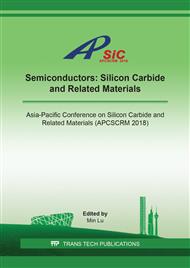p.85
p.90
p.99
p.104
p.109
p.114
p.121
p.126
p.133
Reliability of 4H-SiC (0001) MOS Gate Oxide by NO Post-Oxide-Annealing
Abstract:
In this work, we investigated the oxide reliability of 4H-SiC (0001) MOS capacitors, the oxide was fabricated about 60 nm by thermal oxidation temperature at 1350°C, the oxides than annealed at different temperatures and times in diluted NO (10% in N2). The 4H-SiC MOS structure was analyzed by C-V and I-V measurement. Compared the J-E curves and Weibull distribution curves of charge-to-breakdown for fives samples under different annealing temperature and time, it shows that the high annealing temperature improves the electrical properties as the lifetime enhanced. The mode value of field-to-breakdown (EBD) for thermal oxides by post-oxide-annealing in NO for 30 min at 1350°C was 10.09 MV/cm, the charge-to-breakdown (QBD) of this sample was the highest in all samples, and the QBD value at 63.2% cumulative failure rate was 0.15 C/cm2. The QBD of the sample annealing at 1200°C for 120 min was 0.06 C/ cm2. The effects of NO annealing in high temperature enhance the lifetime of electrical properties and field-to-breakdown obviously. It can be demonstrated that the annealing temperature as high as 1300°C for 30 min can be used to accelerate TDDB of SiC MOS gate oxide.
Info:
Periodical:
Pages:
109-113
Citation:
Online since:
May 2019
Authors:
Price:
Сopyright:
© 2019 Trans Tech Publications Ltd. All Rights Reserved
Share:
Citation:


